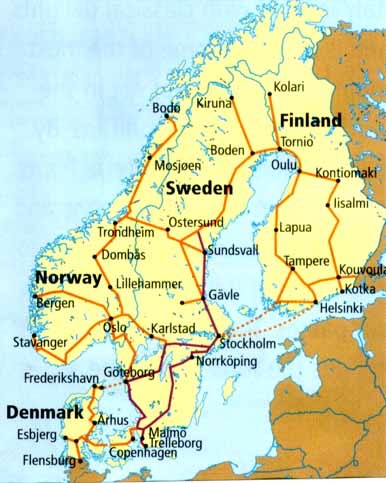Today we sailed into Aalborg on the northern coast of Denmark. The city has Viking roots back to the 5th century, and is relatively new to cruise ship tourism. They were so happy to see us that they set up a Danish hot dog stand within the security gates on the pier and prepared freshly made hot dogs to everyone who wanted them. The Danish claim that while the Americans invented the hamburger, they invented the hot dog.
We took a 3-hour walking tour of the old part of the city. As we saw in Copenhagen, many of their buildings are brightly colored!
This town square, of sorts, serves as a concert venue, and in the winter, they flood it, and it serves as an iceskating rink.
This church was built in two different time periods. The tower on this part clearly shows the year 1779, but in the photo below, you can see the year 1899.
Here's a shot of its interior. It's relatively spartan compared to some of the other cathedrals we've seen further south in Europe.
Sailors who feared for their lives at sea would pray to the Almighty for their safety. If they made it home safely, they would construct a ship to be hung in the local church.
This monument marks the starting point for measuring kilometers in all of Denmark, much like the Puerta del Sol in Madrid. It's 0 km!
This photo shows a monastery dating back to 1431. Initially, it was a poor man's hospital, but later became a monastery/convent where monks and nuns lived. There's a legend that claims that any behavior "beyond talking" between the two groups would be severly punished. In fact, supposedly that type of behavior happened, and the monk was beheaded while the nun was condemned inside a masonry pillar in the basement.
This is the Aalborg City Hall.
This building was built in the year 1624 as you can see in the upper right tower. It was erected by a townsman who wanted to be on the city council, but he could never get elected.
As a way of getting back at the townspeople, he had the masons include faces with their tongues sticking out! Look closely at the top of the masonry work in this photo.
This street housed poor people and the king's soldiers during the mid-16th century. It's really interesting because most people today have taken two homes and combined them together to make a single dwelling to provide more space.
The door on this home shows the provenance up through present day of its owners.
This photo shows an example of the stone sign posts that were used to show that the surrounding area was protected by a certain king. The "R" at the top signifies a certain "kingdom" and the "3 MIL Fra Aalborg" tells how far the post is from Aalborg. They removed the pillars and put them outside a castle in Aalborg.
After our walking tour we went out on our own in search of other interesting sights. Here we saw a city swimming pool, but the pool is actually the river water surrounded by the structure. There are changing rooms and everything off to the side.















